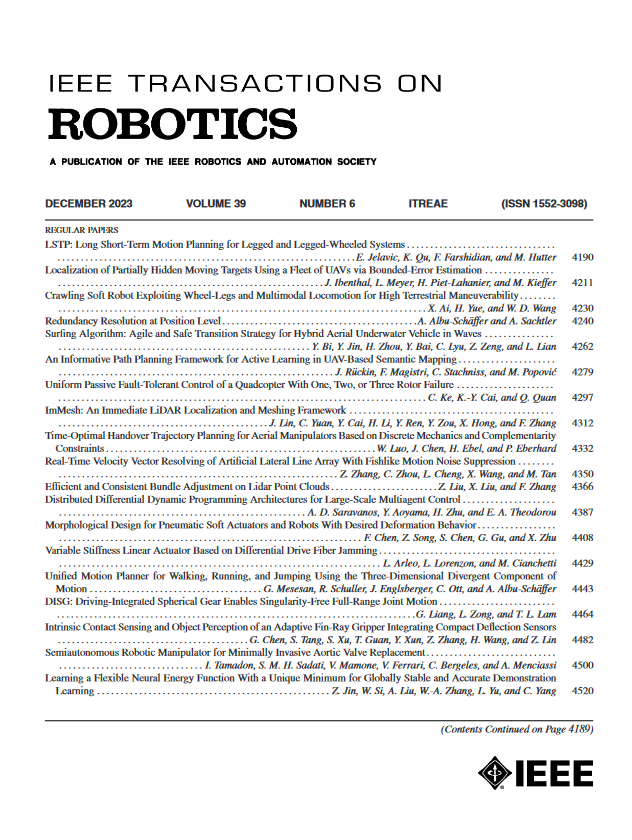SLIM: Scalable and Lightweight LiDAR Mapping in Urban Environments
IF 9.4
1区 计算机科学
Q1 ROBOTICS
引用次数: 0
Abstract
Light detection and ranging (LiDAR) point cloud maps are extensively utilized on roads for robot navigation due to their high consistency. However, dense point clouds face challenges of high memory consumption and reduced maintainability for long-term operations. In this study, we introduce scalable and lightweight LiDAR mapping (SLIM), a scalable and lightweight mapping system for long-term LiDAR mapping in urban environments. The system begins by parameterizing structural point clouds into lines and planes. These lightweight and structural representations meet the requirements of map merging, pose graph optimization, and bundle adjustment, ensuring incremental management and local consistency. For long-term operations, a map-centric nonlinear factor recovery method is designed to sparsify poses while preserving mapping accuracy. We validate the SLIM system with multisession real-world LiDAR data from classical LiDAR mapping datasets, including KITTI, NCLT, HeLiPR, and M2DGR. The experiments demonstrate its capabilities in mapping accuracy, lightweightness, and scalability. Map reuse is also verified through map-based robot localization. Finally, with multisession LiDAR data, the SLIM system provides a globally consistent map with low memory consumption (SLIM:城市环境中可扩展的轻型激光雷达测绘
光探测与测距(LiDAR)点云图由于其一致性高,被广泛应用于道路机器人导航。然而,密集点云面临着高内存消耗和长期操作可维护性降低的挑战。在本研究中,我们介绍了可扩展和轻量级激光雷达测绘(SLIM),这是一种可扩展和轻量级的测绘系统,用于城市环境中的长期激光雷达测绘。该系统首先将结构点云参数化为线和面。这些轻量级和结构化的表示满足了地图合并、姿态图优化和束调整的要求,保证了增量管理和局部一致性。对于长期作业,设计了一种以地图为中心的非线性因子恢复方法,在保持测绘精度的同时稀疏化姿态。我们使用来自经典LiDAR测绘数据集(包括KITTI, NCLT, HeLiPR和M2DGR)的多会话真实LiDAR数据验证SLIM系统。实验证明了该方法在映射精度、轻量化和可扩展性方面的能力。通过基于地图的机器人定位验证地图重用。最后,通过多会话激光雷达数据,SLIM系统以低内存消耗提供全球一致的地图(KITTI上为$ $ 130 KB/km)。
本文章由计算机程序翻译,如有差异,请以英文原文为准。
求助全文
约1分钟内获得全文
求助全文
来源期刊

IEEE Transactions on Robotics
工程技术-机器人学
CiteScore
14.90
自引率
5.10%
发文量
259
审稿时长
6.0 months
期刊介绍:
The IEEE Transactions on Robotics (T-RO) is dedicated to publishing fundamental papers covering all facets of robotics, drawing on interdisciplinary approaches from computer science, control systems, electrical engineering, mathematics, mechanical engineering, and beyond. From industrial applications to service and personal assistants, surgical operations to space, underwater, and remote exploration, robots and intelligent machines play pivotal roles across various domains, including entertainment, safety, search and rescue, military applications, agriculture, and intelligent vehicles.
Special emphasis is placed on intelligent machines and systems designed for unstructured environments, where a significant portion of the environment remains unknown and beyond direct sensing or control.
 求助内容:
求助内容: 应助结果提醒方式:
应助结果提醒方式:


